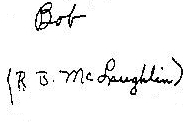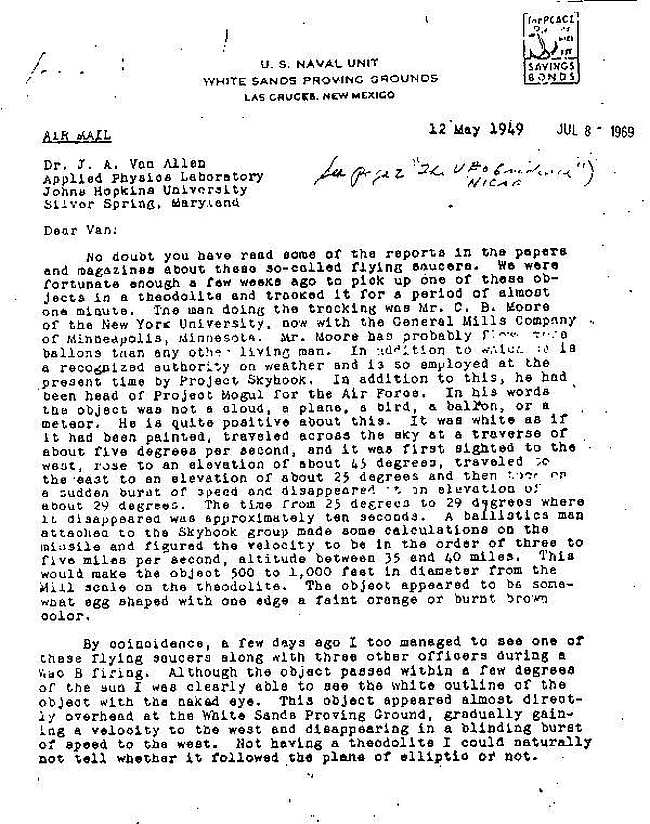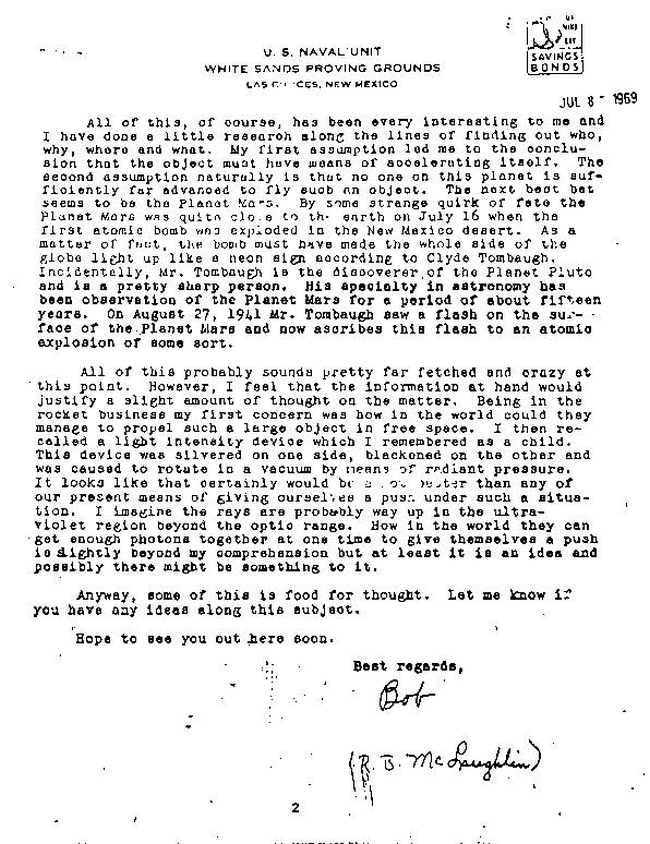PROJECT 1947
Detailing UFO sightings at White Sands Missile Proving Grounds
|
U.S. NAVAL UNIT WHITE SANDS PROVING GROUNDS LAS CRUCES, NEW MEXICO |
|
|
|
|
|
AIR MAIL Dear Van: No doubt you have read some of the reports in the papers and magazines about these so-called flying saucers. We were fortunate enough a few weeks ago to pick up one of these objects in a theodolite and tracked it for a period of almost one minute. The man doing the tracking was Mr. C. B. Moore of the New York University, now with the General Mills Company of Minneapolis, Minnesota. Mr. Moore has probably flown more ballons (sic) than any other living man. In addition to which he is a recognized authority on weather and is employed at the present time by Project Skyhook. In addition to this, he had been head of Project Mogul for the Air Force. In his words, the object was not a cloud, a plane, a bird, a ballon, or a meteor. He is quite positive about this. It was white as if it had been painted, traveled across the sky at a traverse of about five degrees per second, and it was first sighted to the west, rose to an elevation of about 45 degrees, traveled to the east to an elevation of about 25 degrees and then took on a sudden burst of speed and disappeared at an elevation of about 29 degrees. The time from 25 degrees to 29 degrees where it disappeared was approximately ten seconds. A ballistics man attached to the Skyhook group made some calculations on the missile and figured the velocity to be in the order of three to five miles per second, altitude between 35 and 40 miles. This would make the object 500 to 1000 feet in diameter from the Mill scale on the theodolite. The object appeared to be somewhat egg shaped with one edge a faint orange or burnt brown color. By coincidence, a few days ago I too managed to see one of these flying saucers along with three other officers during a WAC B firing. Although the object passed within a few degrees of the sun I was clearly able to see the white outline of the object with the naked eye. This object appeared almost directly overhead at the White Sands Proving Ground, gradually gaining a velocity to the west and disappearing in a blinding burst of speed to the west. Not having a theodolite I could naturally not tell whether it followed the plane of elliptic or not. All of this, of course, has been every (sic) interesting to me and I have done a little research along the lines of finding out who, why, where and what. My first assumption led me to the conclusion that the object must have some means of accelerating itself. The second assumption naturally is that no one on this planet is sufficiently far advanced to fly such an object. The next best bet seems to be the Planet Mars. By some strange quirk of fate the Planet Mars was close to the earth on July 16 when the first atomic bomb was exploded in the New Mexico desert. As a matter of fact, the bomb must have made the whole side of the globe light up like a neon sign according to Clyde Tombaugh. Incidentally, Mr. Tombaugh is the discoverer of the Planet Pluto and is a pretty sharp person. His speciality in astronomy has been observation of the Planet Mars for a period of about fifteen years. On August 27, 1941 Mr. Tombaugh saw a flash on the surface of the Planet Mars and now ascribed this flash to and atomic explosion of some sort. All of this probably sounds pretty far fetched and crazy at this point. However, I feel that the information at hand would justify a slight amount of thought on the matter. Being in the rocket business my first concern was how in the world could they manage to propel such a large object in free space. I then recalled a light intensity device which I remembered as a child. This device was silvered on one side, blackened on the other and was caused to rotate in a vacuum by means of radiant pressure. It looks like that certainly would be a lot better than any of our present means of giving ourselves a push under such a situation. I imagine the rays are probably way up in the ultraviolet region beyond the optic range. How in the world they can get enough photons together at one time to give themselves a push is slightly beyond my comprehension but at least it is an idea and possibly there might be something to it. Anyway, some of this is food for thought. Let me know if you have any ideas along this subject. Hope to see you out here soon.
Best regards,
|


